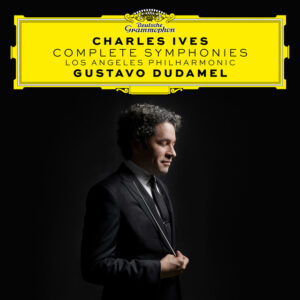GRAMOPHONE Review: Ives Complete Symphonies – Los Angeles Philharmonic Orchestra/Dudamel
 The evolution of American music is chronicled right here in this quartet of symphonies. And when heard – as I did here – in a single sitting – it’s as if Ives is transitioning from the Old to New Worlds before our very ears. The opening paragraph of the First Symphony might be a fragment from a hitherto unknown Schubert symphony – until it quickly becomes apparent that the logic is somewhat skewed and this composer has ideas – and processes – of his own to explore.
The evolution of American music is chronicled right here in this quartet of symphonies. And when heard – as I did here – in a single sitting – it’s as if Ives is transitioning from the Old to New Worlds before our very ears. The opening paragraph of the First Symphony might be a fragment from a hitherto unknown Schubert symphony – until it quickly becomes apparent that the logic is somewhat skewed and this composer has ideas – and processes – of his own to explore.
There’s a moment towards the close of what might at a stretch be called the development of this first movement – a moment close to mystical – where the language is still familiar but the accent and sensibilities are foreign, if not yet ‘American’. Gustavo Dudamel identifies this moment precisely and in the beefy coda which follows his Los Angeles Philharmonic almost give the game away. Their panache is decidedly not central European. The cor anglais solo of the slow movement could be a close cousin of its counterpart in Dvorak’s New World Symphony but the gorgeous string embellishments (exquisitely played) which eventually elaborate it betray an individual (not to say rebellious) talent. And who but a rebellious talent would deploy marching band percussion – but only for the coda of the last movement.
I do like Dudamel’s performance of the Second Symphony. From the moment ‘Columbia, Gem of the Ocean’ raises her head above the rich hymnody of the first movement he and his Los Angelenos are eager to communicate that Ives has all but arrived and that while the old central European influences still enchant him the harmonic and rhythmic displacements are piling in with impunity. Dudamel makes much of the out-of-sync side drum (suggestion of a well-meaning amateur) in the second movement and the vividly pointed contrapuntal square-dancing of the finale is beautifully contrasted with the utter gorgeousness of the second subject idea where solo horn and violins and later solo cello and flute beguile us with the simplest two-part counterpoint.
Occasionally Dudamel misses a trick – like the wildly dissonant ‘wrong note’ trumpets who essentially blow a raspberry at the trombones vulgar rendition of ‘Columbia’. They are barely audible in the concluding melee where they should leap out at us like a deliberate mistake. Mind you, Dudamel does go off at one hell of a lick in the coda impatient to arrive at the Monty Pythonesque pay-off where the proverbial ‘boot’ squashes everything flat with the mother of all discords. Needles to say he does a Bernstein here lengthening the final note from a quaver to an extended crotchet.
Ives is now well and truly Ives. The super-homespun Third Symphony is not writ large (a small chamber orchestra and short duration) but is ripe with Ivesian nostalgia – childhood recollections refracted through magically oblique harmonies and metres. It is the essence of Ives but mellow and reflective of tone and Dudamel – who clearly knows where Ives is coming from – embraces this ‘new normal’ with much affection. Can there be anything simpler or more poignant than the church bells fading from our consciousness at the close?
The Fourth Symphony is a masterpiece – arguably the most important of all American symphonies, certainly the most individual. It is deeply philosophical addressing the whys and wherefores of our existence from the perspective of this most ‘uncommon man’ and when the chorus chant ‘Watchman, Tell Us of the Night’ at the outset in what is probably the shortest but most prophetic movement in symphonic literature we do not anticipate easy answers.
If I have any criticism of this impressive – and forensically lucid – Dudamel account it pertains to the ‘Comedy of Life’ second movement. He certainly lays bare this ultimate Ivesian collage (the orchestral piano part – four hands – especially well revealed) relishing the multiple collisions of Americana as we drift in and out of chaos rocking gently in a kind of semi-consciousness. But I wanted him to convey more enjoyment of the anarchy as this or that popular ditty jostles to make itself heard. ‘Comedy’ is the operative word here.
It has been said that the ‘conservative’ fugue of the third movement is in some ways the most revolutionary movement of all. It sounds so sonorous and organ-like (organ actually underpinning) here – played with relish. But there’s a moment I always wait for towards the close where a solo clarinet contrives its own wonky counterpoint to the strings. So moving, so Ives.
Sonically speaking Dudamel and his DG engineers render the finale impressively. How to describe this cosmic processional with its subterranean out-of-kilter percussion group striving towards some level of synchronicity and wholeness. It is quite literally out of this world – and it was written just after Mahler left us. No wonder Ives was on his radar.
You May Also Like

GRAMOPHONE: From Where I Sit – Awards Issue 2017
15/09/2017
GRAMOPHONE Review: Burnished Gold – Robyn Allegra Parton/Simon Lepper
02/10/2023

